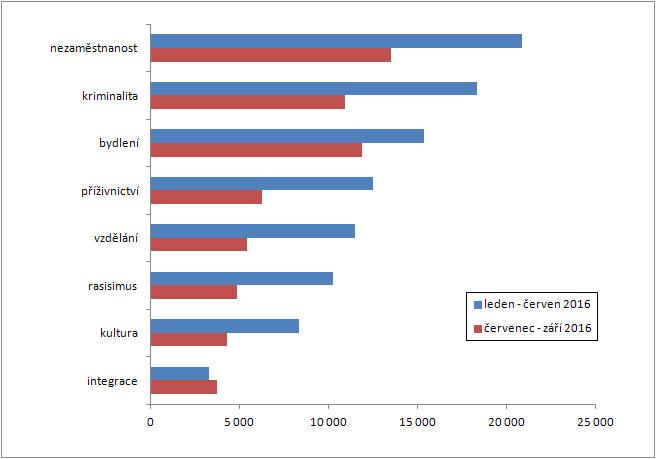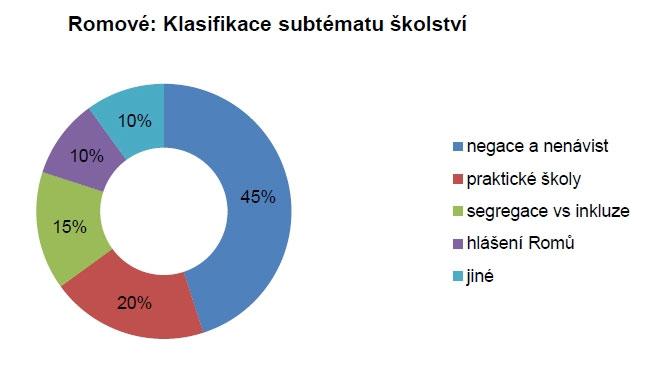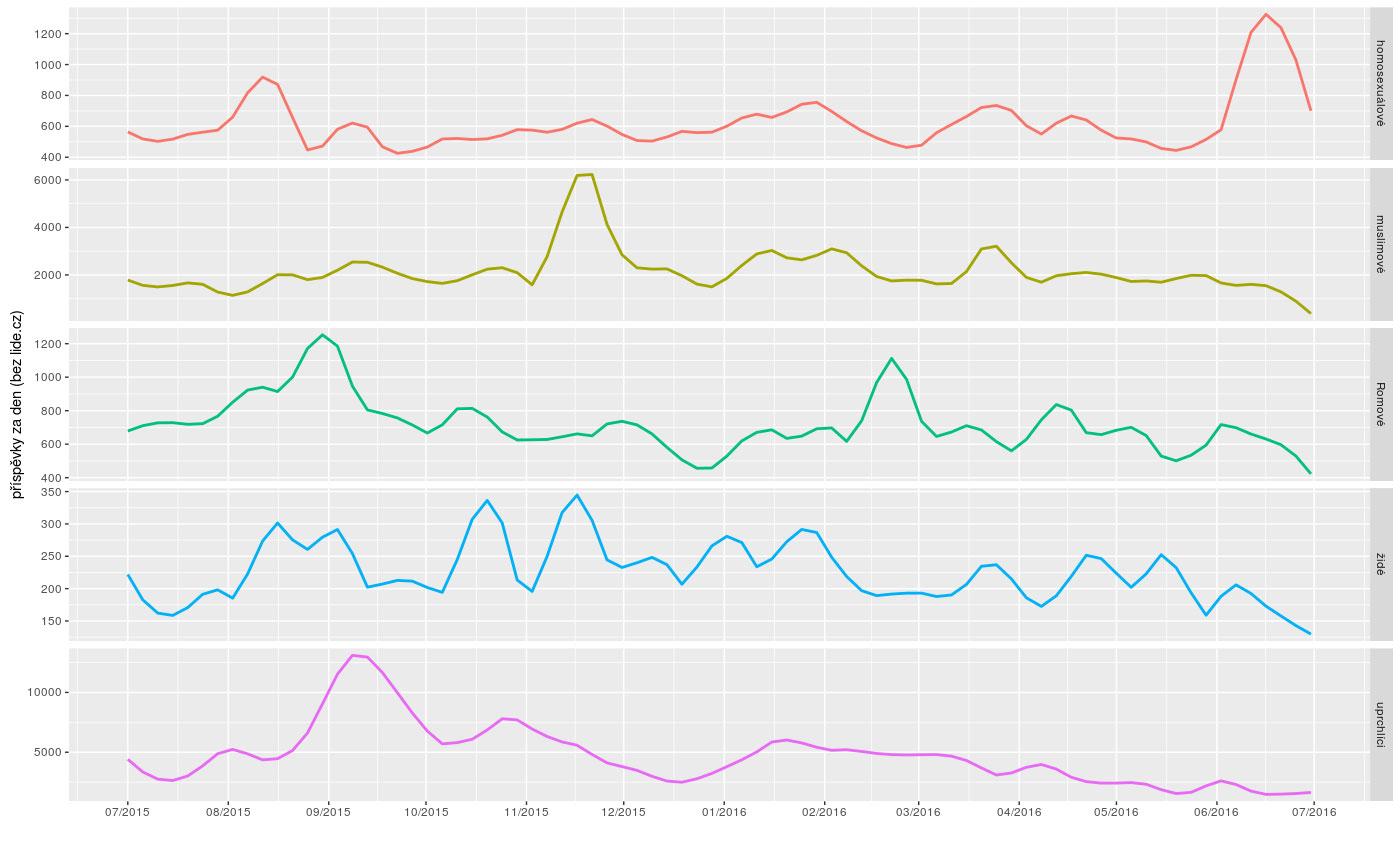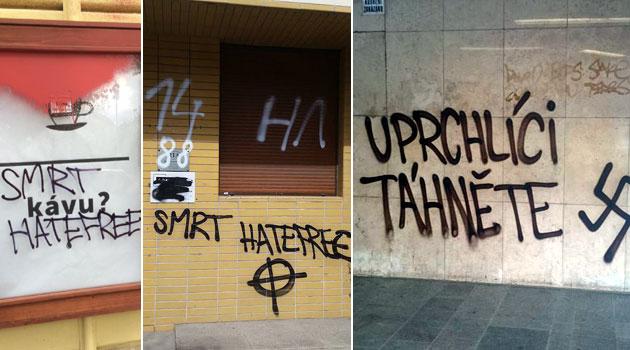Analysis of Czech-language Internet finds posts about Roma worse than two years ago - 80 % negative

Romani people are discussed in the Czech language online predominantly in terms of stereotypes, and the voice of the Roma themselves in the virtual space is still proportionately weak. Media attention towards Romani people as a minority was overshadowed during 2015 and 2016 by a shift of focus to Muslims and refugees, but the emotions expressed about the Roma are, at the same time, more negative than they were before.
The area online for discussions beneath the articles published by almost all leading Czech Internet media outlets is dominated by voices unfriendly to minorities, Roma included. These are the findings of a new analysis of communication about Romani people on the Czech-language Internet published by the Yester company.
For almost two years, Yeseter has been following the Internet in the Czech Republic for the Government’s Hate Free Culture project in order to better comprehend how Internet communication (or “buzz”) about various minorities takes place. During the past two years we have noted more than five million posts in our monitoring that have been about the topic of minorities, and that number rises daily by thousands according to whether a particular theme is “catching on” right then in the media, be that Internet media, social media, or the more traditional forms.
Thousands of posts daily means thousands of Internet conversations that might only peripherally touch on the themes Yeseter has followed. Of course, these individual conversations cannot all be read from beginning to end to comprehend their meaning, as for such a large amount of posts that would be very resource-intensive.
What the Yeseter company does do is mass “buzz monitoring”, i.e., using a computer program to follow various kinds of metadata about all of the publicly-available Internet conversations. By analyzing the “buzz monitoring”, the company then endeavors to find various patterns in the data to aid us in better comprehending genderal tendencies in Internet communications and therefore in the thinking of Internet users.
Thanks to this method, Yeseter can cover a large amount of conversations and identify important speakers, tendencies and trends, but there is no study of how exactly the conversations take place, what the mental processes of the speakers are, or how they make their arguments. It is, therefore, only partially possible to answer the question of how Romani people are being talked about on the Czech-language Internet – it is easier to hit on the quantity of “buzz” than on its quality.
Who is talking about Romani people? I admit that asking how Romani people are discussed on the Internet is a bit of a gauche question, because it ignores that fact that Romani people actually live among us and use the Internet.
Romani people are not just “talked about”, but also “spoken with”, and naturally, “Romani people speak”. These distinctions are a bit lost in the “buzz monitoring” – we follow the incidence of pre-established key words, and according to those words we categorize the posts.
During the past year, as many as 80 % of the posts on the topic of Romani people were negative, while at the end of 2014 “just” about 65 % were. Our method, however, does not capture the exact context of a conversation, the standpoints of the speakers, or even the speakers’ ethnicity, which is why we must aid our comprehension by using various additional analytical methods in which we do our best to contextualize posts on the basis of other metadata besides just the content of the posts themselves.
Therefore we can, with certainty, claim that it is more appropriate for us just to discuss the amount of a (diverse) quantity of “buzz” and conversations about Romani people. The topic of Romani people can be found, for example, in Internet dating, where ethnicity appears to be an important parameter.
We also find it in the regular online speech of non-Roma, where it figures in various stable associations or fixed mental constructs – stereotypes – and a specific position for the “buzz” containing stereotypes includes “jokes about Roma” (although some people allege these are actually more jokes about the Czech way of thinking about Roma). Furthermore, the topic of Roma naturally figures directly in various racist remarks, or Romani people are rhetorically used as a certain yardstick for comparing attitudes toward other minorities, where what is compared is their capacity to adapt, their criminality, and their diligence, most frequently in stereotypical renderings.
Our analysis also demonstrates that the topic of Romani people is, for various speakers, very often an addendum to subject matter about other minorities (especially Muslims and refugees). The topic of Roma naturally is also mentioned online by Romani people themselves, by Romani organizations, and by other active people and organizations who support Romani emancipation or are bothered by social inequality in Czech society.
Conversations on the Internet also have a tendency to combine and overlap, so such categorization always involves a certain simpliflication, but this can aid our understanding that not all “buzz” is equivalent or identical. Sudden spikes in attention In online conversations of various kinds, where the leading role is played by important figures, newspapers, or television, manage to not just boost (or suppress) certain messages, but effectively guides where we focus our attention.
In our analysis, we formed the hypothesis that during the summer of 2015, and especially during the autumn of 2015, the attention of the Czech media space was so focused on the topic of refugees that it led to reduced attention regarding the topic of Romani people, which otherwise has enjoyed attention in the Czech Republic for a long time. However, in order for us to be able to argue that there has been growth in attention, or receding attention, it is not enough to just work with the volume of Internet “buzz” over time – we must focus our attention on a specific phenomenon that we can call “media hype”.
Hype is just such a sudden spike in the intensity of “buzz” about a certain theme. The sudden growth in the volume of mentions about a topic in and of itself frequently leads to people attempting to “figure out what’s ‘in’ “, to focus on the topic more, thereby boosting the hype.
Media hype usually lasts a relatively brief amount of time, but even though it has the tendency to rapidly fall silent, it can remain a long time in the memory of those who participated in it and can be considered a recollection of significance. Hype involves a rather complex social dynamic because it allows us to experience something like a feeling of solidarity when we share a focus on a single, momentarily dominant topic.
Hype actually qualifies as an experience. From our data, it is apparent that from the summer of 2015 to the spring of 2016, there was “hyping” mainly of the topic of refugees, or the related topic of Muslims, but there was little hyping of the topic of Roma, and when that topic was hyped, it was hyped weakly.
This is shown in Figure 1 and Figure 5 below, both of which depict the numbers of posts per day during one year (notice the long-term decline of the topic of refugees). The decline of hype on the topic of Romani people corresponds to the fact that while during the summer months of previous years there had frequently been anti-Romani assemblies, sometimes with outbreaks of anti-Romani violence, in the summers of 2015 and 2016 anti-Romani sentiment did not morph into assemblies, but many assemblies were held that were anti-Muslim and anti-refugee.

Figure 1: Daily “buzz” on the Czech Internet for various minority topics (July 2015 – June 2016, some variations are not visible at this resolution).
Significant topics and negative tone
Even though the topic of Romani people was spared media hype and was not the center of society’s attention, that does not necessarily mean the image of Romani people improved in the Czech Internet environment. Along with the notable hype about Muslims and refugees, which led to a certain societal exacerbation of debates about them, overall sentiment in the “buzz” about Romani people worsened, with 80 % of the posts on the topic of Roma during last year taking a negative tone, while at the end of 2014 “just” 65 % of posts about Roman people had been negative.

Figure 2: Values assigned for feelings about the topic of Romani people overall during the entire period monitored (negative – neutral – positive).
What kinds of topics occur most in the Internet “buzz” about Romani people? The automatic detection of the themes of online coversations is a problematic method for comprehending their content.
The method is based on detecting key words in the vocabulary used to discuss various topics, but this leads to a problem in distinguishing the relevance of the posts – for example, the Czech word for “Romani man”, rom, is also used as a technical term in the context of smartphone services. The discussion about Romani topics generally involves many stereotypes.
However, the problems with the relevance of certain key words are also of a more subtle character – how, for example, are we to compare the relevance of remarks on a racist website read by 1 000 people and a joke about Romani people that is “liked” on Facebook by 10 000? Given this and other methodological problems, it is appropriate to work with detecting these themes just for the sake of orientation, to record tendencies, but for interpretation we must always resort to studies of specific conversations, and that exceeds the grasp of our “buzz monitoring” analysis.
Despite this, on the basis of automatic detection of conversational themes in the “buzz”, we can assert with certainty that the “buzz” about the topic of Romani people is generally quite full of stereotypes. From the beginning of our monitoring in 2014, the most significant topics associated with Romani people have long been the same: “unemployment”, “criminality”, “housing”, “parasitism”, “education”, “racism” (these are our own classifications).
As can be seen in Figure 2, topics like “culture” or “integration” are not very significantly associated with Romani people. We could also continue in greater detail, as we are able to do, for example, on the topic of education (see Figure 4), where the questions of education and training are most frequently connected directly with hate speech and the topics of “practical schools”, “segregation and inclusion” or “counting Romani people”.
Because the results are based on the overall data, it is apparent that in the Czech “buzz” about the topic of Romani people, we mostly encounter “talk about Roma” that is stereotypical. For example, the not-too-frequent online conversations about emancipation have a different thematic and value composition (here what is important are the topics of education, labor, poverty and success, depictions of Roma in the media, etc.), while in the environment of dating, on the other hand, just a minority of posts is focused on broader social topics (and therefore a large number of these posts cannot be assigned to sub-topics).

Figure 3: The topic of Romani people – numbers of posts according to sub-topics – two different time periods
The thematic composition of the “buzz” on the topic of Romani people and its predominantly negative sentiment presents an unflattering image of the mainstream Czech way of reflecting about and speaking about Romani people, and it is necessary to add that this is not just about the “buzz” in various online commentaries, but also statements by various politicians and the news reporting by newspapers and television stations. The tendency to repeat stereotypes means that in the “buzz” on the topic of Romani people what is lacking is any discussion of actual Romani lives with all of the ambiguities, contradications and discrepancies that we (non-Roma) perceive so naturally about ourselves.
Remarks that do not involve stereotypes come from Romani men and women themselves as well as from institutions and activists around the movement for their equality, or from state institutions that espouse their equality, or from the academic environment. Such differences in the way these different groups of actors are speaking and thinking pose the danger of shoring up existing barriers to mutual comprehension.

Figure 4: The topic of Romani people, sub-topic of education – representation of posts according to sub-topics (July-September 2016) The categories from top to bottom: negativity and hatred, practical schools, segregation vs. inclusion, identification of Romani people, other.
In the first image we are capturing trends in the occurrence of posts on the themes monitored during the past year. This shows that “buzz” on the topic of refugees achieves approximately 10 times the volume of the “buzz” on the topic of Romani people.
Moreover, as we mentioned above, “buzz” on the topic of Romani people contains a limited amount of hype (this is apparent in more detail from the last graph), so we can speculate that if attention had not been deflected away to the topic of refugees, the hype about Romani themes would have been more dynamic and noticeable.
Nevertheless, to uphold this hypothesis it is necessary to research the change in priorities among the speakers who favor the production of negatively-tinged remarks about minorities. In the introduction we mentioned that individual remarks cannot be comprehended without knowledge of the context of an entire conversation, and there we hit upon an essential characteristic of Internet communications: It does not take place in a vaccuum, but leads to the creation of communities, groups, societies of people, which gradually leads to the creation of shared experiences, history and values.
Society, then, creates a certain framework in which meaning, values and the other cultural characteristics of that society crystallize. The diversity of society means there is not just a better capacity to consider various perspectives and facilitate the simultaneous existence of various contradictory views, but also improved capacity for these deliberations, i.e., seeking the best ways to find the best solutions to problems.

Figure 5: Daily “buzz” on the Czech Internet on various minority topics – individual graphs (July 2015 – June 2016).
Variety of themes among contributors to various websites
We looked at various web platforms and how their users, during the past year, were inclined to express themselves about various minority topics – whether, for example, all of them expressed themselves on the dominant themes, or whether the various themes coexist separately. For all users we assessed which topics they expressed themselves about during the period of one year, and we compared the overlap of the themes among users on various web platforms.
The platforms then stratified into several types:
1) Platforms where there is no great dominance of users expressing themselves simultaneously about all of the minority topics monitored and, at the same time, none of the minority topics is significantly dominant among the users: facebook.com, twitter.com, nyx.cz, okoun.cz
2) Platforms where there is not a great dominance of users expressing themselves simultaneously about all of the minority topics monitored and, at the same time, the themes of LGBT people or Roma significantly dominate: lide.cz, ask.fm, emimino.cz
3) Platforms where there is not a great dominance of users expressing themselves simultaneously about all of the minority topics monitored and, at the same time, the themes of Muslims and Refugees significantly dominate: zahranicni.ihned.cz, domaci.ihned.cz, reflex.cz, pravyprostor.cz
4) Platforms where there is not a great dominance of users expressing themselves simultaneously about all of the minority topics monitored and, at the same time, the themes of Muslims, Refugees and Roma significantly dominate:zpravy.aktualne.cz, tn.nova.cz, blesk.cz
5) Platforms where users expressing themselves about all of the minority topics monitored significantly dominate and at the same time the theme of Muslims and Refugees significantly dominate: zpravy.idnes.cz, novinky.cz, parlamentnilisty.cz, echo24.cz, blog2.idnes.cz, lidovky.cz
We see that between types 3-5, important mainstream news portals are included. For the news websites, it is characteristic that Muslims, refugees and Romani people are excessively accented in their discussion platforms.
We also find a higher concentration of users on those websites who express themselves regarding all minority themes (Category 5). Compared to that, we find web platforms where the themes of LGBT people, minorities living in the Czech Republic and Romani people are significantly represented (Category 2), but themes that significantly dominate on the news websites are comparatively less represented.
Websites in Category 1 offer room for remarks about various minorities but no themes predominate, nor do users expressing themselves on any of the themes that predominate – this is the case of Facebook, where a big number of people of different opinions coexist who discuss minority topics, even though they may not ever encounter each other when discussing the topics. From these results, the very important finding follows that the societies arising from these various webs platforms are very diverse with respect to their relationships toward minorities.
We are decidedly not acting in a “flat” landscape that might make it possible for us to unequivocally attribute thematic “buzz” to a single, clear category. If we have a strong perception of the existence of stereotypical “buzz” about Romani people, and the data confirms it, that does not mean the use of the stereotypes is the same everywhere it occurs.
Where there is more room for conversations about various minorities and with the representatives of those minorities, the tendency to use stereotypes is weaker. In the case of news portals, it’s apparent that the conditions for interaction on these platforms leads to the dominance of some themes, and even to the dominance of users who express their views of more than one minority theme at the same time.
The outcome is an environment for “online discussion beneath articles” that is neither favorable towards those who advocate for minorities nor safe. Those of differing opinions in that environment are very rapidly confronted with the dominant themes and users.
We are still learning to understand “buzz”
From the data collected during 2015-2016 we find it difficult to draw general conclusions, because this was a very specific time period with respect to the perception of minorities, mainly because the new, strong themes of “Muslims and refugees”,emerged in the Czech environment. Despite this, the data for this period might serve well when compared with the “buzz” of other periods, especially if the “buzz” on hating Romani people again predominates and we experience significant hype on that theme – we have seen that each topic hyped ultimately fades and sooner or later a new one is hyped instead.
